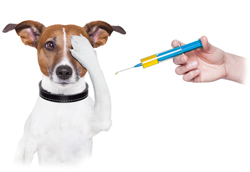 Every year our pets make that dreaded trip to the vet for his wellness examination and recommended annual vaccinations. Veterinary clinics have become a booming business thanks to these yearly shots that our pets get, but what if the only reason these inoculations are recommended is to help fund the clinic? Fear mongering is the leading cause of over vaccination in dogs today, and it is something many veterinarians are well versed in doing. They help to fuel the fire of fear in pet owners, warning all the deadly dangers of not vaccination. Science and biology however state otherwise, and your pets may be protected for life with only one vaccination.
Every year our pets make that dreaded trip to the vet for his wellness examination and recommended annual vaccinations. Veterinary clinics have become a booming business thanks to these yearly shots that our pets get, but what if the only reason these inoculations are recommended is to help fund the clinic? Fear mongering is the leading cause of over vaccination in dogs today, and it is something many veterinarians are well versed in doing. They help to fuel the fire of fear in pet owners, warning all the deadly dangers of not vaccination. Science and biology however state otherwise, and your pets may be protected for life with only one vaccination.
The Purpose vs. The Reality
The reason vaccinations were created for animals is to help keep them protected from communicable diseases. Rabies vaccinations help protect humans as well, meanwhile others such as the Parvovirus and Distemper vaccines protects our pets and working animals. Once it was widely well known that protecting our furry friends as family members as a top priority, monetary exploitation in veterinary care became more popular.
Years ago, it was more cost effective and healthier for owners to ask for a titer test instead of just another vaccination. A titer test is a very simple blood test that looks for the antibodies of certain diseases such as Parvovirus, Distemper and even Rabies. If the count is at an ideal or safe number, no vaccination is given because it is biologically not needed; the animal is already protected from previous vaccinations! As times changed, yearly vaccinations became cheaper for the client and brought in more money for the clinics. Furthermore, the American Veterinary Medical Association recommended yearly shots as well as boosters for puppies at ages 6 weeks, 10 weeks and 12 weeks of age. Meanwhile, studies in the biology of the puppy may contradict this. A puppy’s mother’s milk contains her antibodies and can protect the puppy up to 12 weeks of age. This means any vaccinations given prior to that age won’t have any effects in preventing disease, but still poses the same risks all vaccinations do, giving no benefit and all risk.
Risks involved with any vaccination include anaphylaxis, or an allergic reaction to the vaccine itself. The tricky thing about anaphylaxis is that even if your pooch has handled vaccines fine in the past, it could happen with any future shots given. Autoimmune hemolytic anemia is another risk taken when giving a vaccination to a dog. Symptoms include weakness, lethargy, loss of appetite labored or difficulty breathing, diarrhea, vomiting and increased heart rate. This is easily a life threatening condition if not treated, and may require life long therapy. Localized reactions are also quite common, including cancer at the vaccination site.
High Risk Dogs
Some breeds and sizes of dogs are at a higher risk of adverse reactions and illness from vaccinations. Smaller breeds are especially more likely to have problems with a yearly vaccination simply due to their size and the vaccinations used. There is no vaccination made specifically for smaller dogs. When it comes to vaccines, manufacturers create them with the mind set of one size fits all. The amount of vaccine a Great Dane receives is no different than that of your teacup sized Maltese.
Some breeds are also at a greater risk than others. Akitas, Cocker Spaniels, German Shepherd Dogs, Dachshunds and Poodles are all predisposed genetically to have adverse reactions to vaccinations. Symptoms such as seizures, high fever and painful episodes of hypertrophic osteodystrophy plague these animals when vaccinated, particularly before they reach young adulthood.
When to Vaccinate and Minimize Risk
Your first step to protect your dog is to visit a veterinarian, but also to educate yourself on the risks and benefits of any medical decision. Never obtain your information from biased sources, including your local vet who benefits monetarily from your decision to accept his suggestions. Studies show that one vaccination for diseases such as Parvovirus, Canine Influenza and Distemper at the age of 12 to 16 weeks could potentially protect your dog for his entire life. Every vaccination is a risk, but if your dog only needs one to last a lifetime, why continue giving him the shot on a yearly basis?
Find Toys, Treats and Gifts for Your Dog at Pampered Paw Gifts